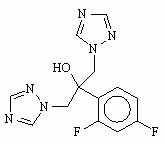Fluconazole
Fluconazole is a synthetic antimycotic drug of the triazole class of compunds. The drug is sold under the brand name Diflucan®. It is used orally and intravenously to treat yeast and other fungal infections. more...
Mode of action
Fluconazole inhibits, much like the imidazole-antimycotics, the fungal P450-enzyme. The consequences are that Lanosterol can no longer be converted to Ergosterol. Ergosterol is an essential part of the fungal membrane and its deficit alters the permeability of the membrane and this eventually disrupts fungal growth. It acts fungistatic or fungizide depending on the susceptibility of the strain and the dose regime used. Fluconazole is theoretically capable of inhibiting demethylases in the human body, but this effect is not seem with therapeutic doses.
Susceptible fungi
Animal models (infection studies) showed that fluconazole is active against infections with strains of Candida, Cryptococcus, Aspergillus, Blastomyces, Coccidioides and Histoplasma. In vitro test systems are still inreliable.
Pharmacokinetic data
Following oral dosing, fluconazole is almost completely absorbed within two hours. The high bioavailability of over 90% is not significantly reduced by concomitant intake of meals and co-medication with H2-antagonists (e.g. cimetidine, ranitidine). Concentrations measured in urine, saliva, sputum and vaginal secrete are approximately equal to the plasma concentration measured following a wide dose range from 100 to 400 mg oral as a single dose. The half-life of fluconazole is approximately 30 hours and is increased in patients with impaired renal function.
Elimination and excretion
Fluconazol is renally eliminated and primarily (80%) excreted in the urine as unchanged drug.
Carcinogenicity
Male rats treated with 5 mg and 10 mg/kg weight respectively showed a higher incidence of hepatocelluar adenomas than expected. No data exists on human carcinogenity.
Uses
- Infections with Candida in mouth and esophagus.
- Recurrent vaginal infections, if local therapy is not sufficient.
- Prophylaxis of infections with Candida in tumor patients receiving chemo- or radiotherapy.
- Treatment of deep or recurrent fungal infection of the skin (dermatomycosis), if local treatment was not successful. The efficacy of fluconazole in the treatment of onchomycosis (fungal infection of the nails) has not been demonstrated.
- Sepsis due to emergence of Candida in the blood (candidaemia).
- Meningitis and prophylaxis of meningitis caused by cryptococcus in AIDS-Patients. In a subgroup of patients Fluconazole acts more slowly than amphotericin B alone or in combination with flucytosine. Nonetheless, response and curation rates were not significantly different.
- Treatment of blastomycosis, histoplasmosis, coccidioidomycosis, sporotrichosis, and aspergillosis. Sometimes amphotericin B is the preferred agent.
Read more at Wikipedia.org



